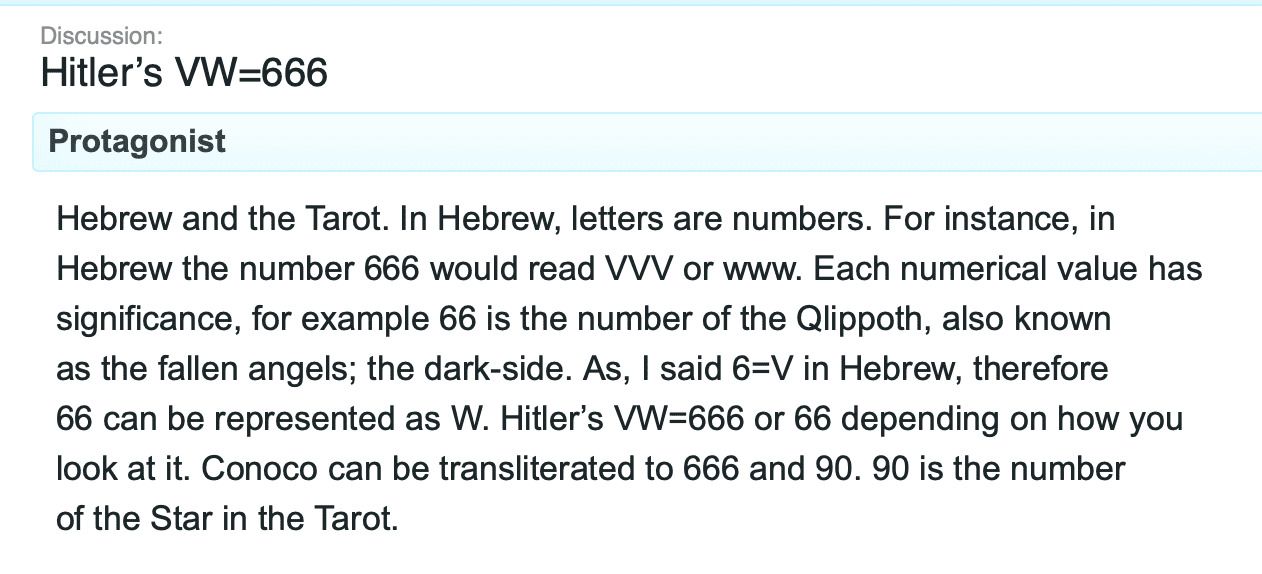Think Volkswagon is just a nice, friendly boring little German company?
Well….you might be surprised to learn a few things.
Let’s start with this:
I saw a while back, if you spin a VW wheel cover or logo at the right RPM it looks like a swastika. Also, isn’t Porsche affiliated with VW/Audi?
— Trumpheart (@jasonca55352405) October 12, 2018
I saw that on Twitter and thought: “that can’t be true”.
Just click-bait crap.
But then?
Then I tested it.
Sorry folks….don’t believe it? It’s still true.
Watch here on Rumble:
Here’s a backup:
Is this correct?

But that’s not all.
Actually, we’re just getting started.
Did you know the name (VW) or (V V V) works out to 666?
It’s true:
Just a coincidence, I’m sure.
And of course you know the history between the auto-company and Hitler himself right?
Right?
From DW:
Two men, one huge project: Adolf Hitler and Ferdinand Porsche are the people behind the Volkswagen Beetle. Porsche was the genius engineer, Hitler the sly politician. “These two were made for each other,” said Wolfram Pyta, a history professor at the University of Stuttgart.
He, along with historians Nils Havemann and Jutta Braun, have written Porsche: From design office to global brand. The book traces the company from its founding in Stuttgart on April 25, 1931.
Porsche’s Volkswagen project could never have been realized without Hitler’s support. “Hitler needed a creative mind to produce his compact car suitable for mass production,” Pyta said. “And Porsche needed political backing to enable him to build it without financial pressure.”
Hitler announced a “people’s motorization” at the auto show in February 1933, just weeks after he was named Reich Chancellor. In summer 1934, the Reich Association of the German Automobile Industry gave Porsche the task of coming up with a car under the motto “strength through pleasure,” after the same name as the Nazi’s Organization for Leisure Activities.
Hitler, who did not have a drivers license, personally approved the prototype of “his Volkswagen” on December 29, 1935. Not much more than two years later, on May 26, 1938, the cornerstone was laid for the Volkswagen factory in Wolfsburg, with the Führer in attendance.
However, the car built for “strength through pleasure” was foremost intended for the German army, not the “people’s motorization.” It was put to military and all-terrain use on the front. This surprised few. A Porsche brochure in 1934 said a “car must be suitable not only for personal use, but also for transport and particular military purposes.”
And more, from Jalopnik:
There’s no denying the role of Nazi Germany and a certain failed artist with a funny mustache had in the creation of Volkswagen. Well, maybe VW denies it a little bit, since their Volkswagen Classics department (VW corporate’s heritage collection) doesn’t include any cars prior to 1950 and they really, really don’t like talking about that era.
The truth is, of course, far more complicated than “the Nazis founded Volkswagen,” because, really, that’s not exactly true. The whole history of the Beetle and the company that was created to build the car and then, after the war, sell the car all over the globe is actually quite interesting, and, really, has less to do with Hitler than you think.
Virginia Is The Latest State To Ban The Carolina Squat
Also, as an aside, it should be mentioned that while VW tends to get most of the Nazi associations, they were hardly the only ones with dirty hands. It’s worth remembering that nearly every picture of Hitler in a car has him in a Mercedes-Benz. It’s also worth remembering that GM’s Opel division wasn’t shy about working for the Nazis, and that Henry Ford once received a birthday card from Hitler himself. Almost every industrialist from the leadup to World War II looks bad today.So, before some other smug Portlander warms up their color printer and trots out this tired old meme, let’s lay out the actual truth here. I’m going to break down Volkswagen into parts to be as thorough as possible:
The Concept
The fundamental idea behind Volkswagen, and the idea that gave the company its name, is the idea of a people’s car. A car that’s affordable and practical enough for almost everyone to own one. While it was certainly a goal of Hitler’s, this idea is far older than Nazism itself, and has been around ever since mass-produced cars came around. The curved-dash Olds might be considered to be the first major attempt to make such a car, and the Ford Model T was the first car to really become a true people’s car, starting way back in 1908.
Even in Germany, the people’s car idea was well-established long before the Nazis. The very primordial Beetle-like Hanomag Kommisbrot from 1925 could easily be considered to be a people’s car, for example.
I’ve been sort of obsessed lately with the murky pre-history of the VW Beetle. It’s one of the most
Another Beetle ancestor, the Standard Superior, was even advertised using the word “volkswagen” because that word was already well-known and understood to mean an affordable small car for anybody. Basically, exactly what the Beetle would become.
So, conceptually, the idea of a ‘volkswagen’ is not Hitler’s or any particular Nazi. It predates National Socialism by a good couple decades, at least.
The Fundamental Design of the Beetle
Another popular misconception that you hear often is that Adolf Hitler ‘designed’ the car that would come to be known as the VW Beetle. While Hitler did draw a couple sketches of what he thought a volkswagen should look like, those drawings do not look like the final Beetle (it really resembles a number of rear-engine designs of the era, such as the Mercedes-Benz 130H, and Hitler certainly wasn’t an automotive engineer. So this just isn’t true — Hitler did not design the Beetle.
Closer to the truth, but still not entirely accurate is that Ferdinand Porsche designed the car. Porsche certainly did (with the help of Erwin Komenda for the body design) design the car that would become the VW Beetle, with the familiar final design completed by 1938.
So while the particular final design was done by Porsche, that design didn’t just leap from Porsche’s fertile brains. The VW Beetle was really the culmination of a whole school of automotive thought happening in Europe — especially Germany — in the 1920s and 1930s, starting with Edmund Rumpler’s rear-engined, streamlined cars.
The ideas of a backbone chassis, rear engine, air cooling, and a scarab-like, streamlined body were being explored by many people at that time. Josef Ganz, an automotive journalist and car designer, had started building prototypes of very Beetle-like cars for companies like Adler and later a production car, the Standard Superior. Ganz was a Jew, so the Nazis made sure that his input to the development of any German cars stayed unknown for years.
Mercedes-Benz had their 130H and 170H rear-engine cars, Zündapp commissioned Porsche before his involvement with the Nazi government for a rear-engined, Beetle-like car, and the Czech company Tatra was designing large, powerful V8 rear-engined, air-cooled, streamlined cars — and a smaller, very Beetle-like car — that were greatly admired by Hitler and provided Porsche with a lot of, um, inspiration. Inspiration that resulted in VW paying Tatra a 1 million Deutsche Mark settlement in 1965.
So, while Porsche definitely produced the final design that would become the Volkswagen, it’s more fair to say that he created a design that was heavily based on work by many other companies and designers.




Join the conversation!
Please share your thoughts about this article below. We value your opinions, and would love to see you add to the discussion!